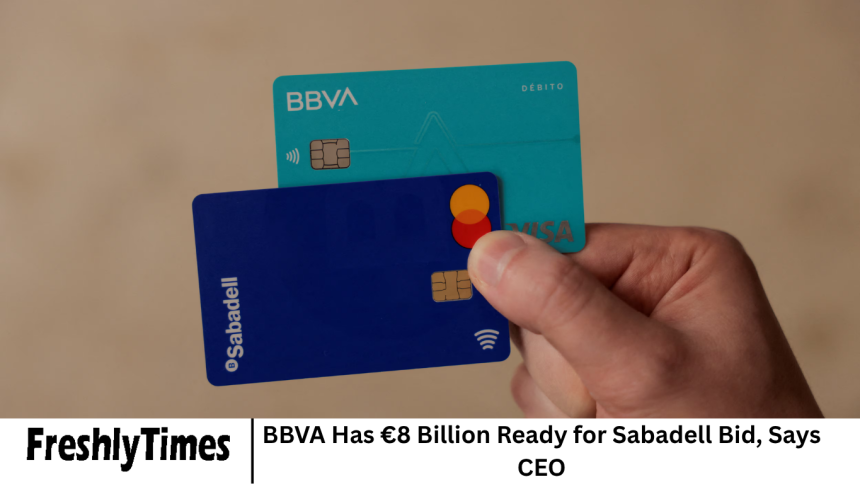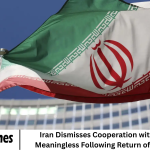In a move that could reshape Spain’s banking landscape, Banco Bilbao Vizcaya Argentaria (BBVA) has confirmed it has up to €8 billion available to fund a mandatory takeover bid for Banco Sabadell, should the need arise. The declaration by BBVA’s Chief Executive Officer has reignited discussions.
- CEO’s Declaration: €8 Billion Ready and Available
- Understanding the Legal Context: Voluntary vs. Mandatory Bids
- Market Reaction: Confidence and Caution
- Strategic Implications for BBVA
- Strengthening Domestic Market Position
- Leveraging Digital Strength
- Diversifying Geographic Exposure
- Realizing Cost Synergies
- Challenges and Risks
- Why the €8 Billion Matters
- The Broader Context: Consolidation in European Banking
- Sabadell’s Response: Standing Firm
- Analyst Opinions: Mixed but Intrigued
- What Happens Next
- Frequently Asked Question
- Conclusion
Around consolidation within Europe’s financial sector and highlighted the bank’s growing appetite for strategic expansion amid evolving market conditions. The announcement underscores BBVA’s confidence in its balance sheet and its determination to strengthen its position in Spain’s highly competitive banking market.
It also puts pressure on both regulators and Sabadell’s management, as the potential deal could redefine the structure of the Spanish banking sector, creating one of Europe’s largest financial institutions by assets and market capitalization.
More Read: Firefly Expands National Security Portfolio with $855 Million Acquisition of SciTec
The Background: A Long Pursuit of Sabadell
BBVA’s interest in Banco Sabadell isn’t new. The Spanish banking giant first expressed takeover interest in 2020, but those talks collapsed after disagreements over valuation. At the time, Sabadell argued that BBVA’s offer undervalued the bank’s future potential and ongoing digital transformation efforts.
Fast-forward to 2025, BBVA’s renewed pursuit of Sabadell reflects a broader trend of consolidation across the European banking landscape. As rising interest rates, inflationary pressures, and digital disruptions reshape the financial industry.
Many banks see mergers as a strategic pathway to achieve economies of scale, reduce costs, and improve competitiveness. Sabadell, which has a strong presence in small and medium-sized enterprise (SME) lending and regional markets like Catalonia.
CEO’s Declaration: €8 Billion Ready and Available
Speaking at a recent investor event, BBVA CEO Onur Genç confirmed that the bank has €8 billion in available liquidity to support a potential mandatory takeover bid for Banco Sabadell, should regulators require it.
This statement comes amid ongoing discussions about the future of BBVA’s voluntary offer, which has yet to gain full approval from Sabadell’s shareholders. Genç emphasized that BBVA’s financial position is strong, supported by a robust capital ratio.
And healthy profits across its international divisions, particularly in Mexico and Turkey. “We are well-prepared financially,” he stated. “We have ample resources to pursue strategic opportunities, including Sabadell, if the process requires a mandatory offer.”
His comments suggest that BBVA is willing to comply fully with Spain’s market regulations, which may trigger a mandatory bid if the bank acquires a certain threshold of Sabadell’s shares.
Understanding the Legal Context: Voluntary vs. Mandatory Bids
In Spain, takeover bids are regulated by the National Securities Market Commission (CNMV). When a company acquires more than 30% of another listed firm’s shares, or otherwise gains control, it must launch a mandatory takeover offer to ensure equal treatment of all shareholders.
BBVA’s current approach is voluntary—it has proposed an all-share offer that would exchange BBVA stock for Sabadell shares. However, if BBVA secures significant shareholder support or acquires enough shares to cross regulatory thresholds, a mandatory bid may be triggered.
The €8 billion war chest signals BBVA’s readiness to meet such obligations. Analysts view this as a demonstration of the bank’s strategic foresight and its determination to reassure investors that it has the liquidity and financial muscle needed to complete the acquisition under any scenario.
Market Reaction: Confidence and Caution
The markets have responded with mixed reactions to BBVA’s statement. On one hand, investors appreciate the clarity and confidence expressed by the bank’s leadership. BBVA’s stock experienced a modest uptick following the CEO’s remarks, reflecting optimism about the bank’s growth trajectory.
And its ability to finance the deal without jeopardizing capital strength. However, Sabadell’s shares have also seen volatility. While the potential acquisition could yield synergies and efficiency gains, some investors worry that BBVA might.
End up paying a premium, particularly if a mandatory bid becomes necessary. Sabadell’s board has so far resisted BBVA’s overtures, arguing that the bank’s standalone strategy is producing strong results and that its current valuation does not fully reflect its market potential.
Credit rating agencies and financial analysts are closely monitoring the developments, emphasizing that while consolidation could create a more competitive institution, execution risks remain high. Integrating two large banking operations, particularly with distinct customer bases and regional cultures, could prove challenging.
Strategic Implications for BBVA
The acquisition of Sabadell would position BBVA as a dominant player in Spain, with a significantly expanded market share in both retail and SME banking. It would also enable BBVA to leverage Sabadell’s strong digital infrastructure and its established footprint in the UK banking sector through TSB.
Strengthening Domestic Market Position
Currently, BBVA faces stiff competition from CaixaBank and Banco Santander in Spain. By absorbing Sabadell, BBVA could challenge CaixaBank’s position as the country’s largest domestic lender. The merger would also create efficiencies through branch consolidation and shared technology investments.
Leveraging Digital Strength
Both BBVA and Sabadell have invested heavily in digital transformation. BBVA is widely recognized as one of Europe’s most innovative banks in terms of digital banking, while Sabadell’s efforts in modernizing its platforms have also gained traction.
A merger could create a banking powerhouse capable of competing with fintech challengers and neobanks.
Diversifying Geographic Exposure
Sabadell’s UK arm, TSB Bank, would add valuable diversification to BBVA’s largely European and Latin American portfolio. It would provide a stable foothold in a mature market with long-term potential, even amid post-Brexit uncertainties.
Realizing Cost Synergies
Analysts estimate that a combined BBVA-Sabadell entity could achieve annual cost savings of around €1 billion, primarily through branch optimization, shared IT systems, and reduced administrative expenses.
Challenges and Risks
While the potential benefits are clear, several challenges could complicate BBVA’s acquisition strategy.
Regulatory Approval
Mergers of this scale require approval from multiple regulators, including the CNMV, the European Central Bank (ECB), and the Spanish Competition Authority (CNMC). Regulators will closely examine potential competition issues and systemic risks.
Cultural Integration
Merging two banks with distinct corporate cultures can be complex. Sabadell has deep regional roots, especially in Catalonia, while BBVA’s culture is more global and digitally oriented. Aligning management structures and employee expectations will require careful planning.
Political Sensitivity
Large-scale bank mergers often attract political attention, particularly when they could result in branch closures or job redundancies. Spanish labor unions have already voiced concerns about potential layoffs, urging the government to ensure that workers’ rights are protected.
Market Conditions
With global markets facing economic uncertainty, including fluctuating interest rates and slowing growth, the timing of such a large-scale acquisition could be risky. Any downturn could affect both banks’ profitability and share prices, complicating deal negotiations.
Why the €8 Billion Matters
BBVA’s disclosure of the €8 billion funding availability serves multiple strategic purposes.
- Investor Reassurance: It demonstrates to investors and regulators that the bank has ample liquidity to pursue the deal responsibly.
- Negotiation Leverage: By showing financial preparedness, BBVA signals to Sabadell’s board that it can sustain a prolonged acquisition effort if necessary.
- Regulatory Compliance: Having funds set aside positions BBVA to meet any mandatory bid obligations under Spanish takeover law.
- Market Confidence: It reinforces BBVA’s reputation as a stable, well-capitalized institution capable of navigating complex financial transactions.
According to financial analysts, the funding likely comes from a combination of retained earnings, debt issuance capacity, and potential asset sales. BBVA’s strong performance in its key markets—Spain, Mexico.
And Turkey—has generated sufficient capital buffers to support such a move without undermining its financial health.
The Broader Context: Consolidation in European Banking
The potential BBVA-Sabadell merger is part of a wider consolidation wave in Europe’s banking industry. Since the 2008 financial crisis, regulators have encouraged mergers among mid-sized banks to build resilience and reduce systemic risks.
However, cross-border mergers have remained rare due to differing national regulations and political resistance.
Spain, in particular, has seen several major mergers in recent years, including:
- CaixaBank’s merger with Bankia in 2021.
- Unicaja’s acquisition of Liberbank in 2022.
If BBVA successfully acquires Sabadell, it would continue this trend, potentially inspiring other banks across Europe to explore similar deals.
Sabadell’s Response: Standing Firm
Banco Sabadell’s leadership has maintained a firm stance against BBVA’s offer. CEO César González-Bueno has repeatedly argued that Sabadell’s standalone plan—focusing on profitability, efficiency, and digital expansion—is delivering strong results.
In the first half of 2025, Sabadell reported a solid rise in net income, improved return on equity, and a stronger capital ratio, signaling that the bank is recovering well from past challenges.
González-Bueno has also stressed that Sabadell’s management is committed to maximizing value for shareholders independently, not through a takeover. Sabadell’s board remains cautious about potential integration risks and employee impacts.
Yet, some institutional investors are reportedly open to discussions, recognizing that a merger could unlock long-term value if executed properly.
Analyst Opinions: Mixed but Intrigued
Financial analysts remain divided over the deal’s prospects.
Optimists argue that BBVA’s acquisition of Sabadell would create a more robust Spanish banking system, capable of competing internationally. They highlight potential cost savings, digital synergies, and a stronger market position.
Skeptics, however, warn that the deal could prove complicated and costly. They note that mergers of this size often face regulatory hurdles, cultural friction, and integration costs that can offset expected gains.
Investment banks such as Goldman Sachs and Morgan Stanley have issued reports noting that while BBVA’s balance sheet can absorb the acquisition, the bank must manage investor expectations carefully to avoid overpaying or diluting shareholder value.
What Happens Next
BBVA’s declaration that it has €8 billion ready marks a turning point in the takeover saga. The next steps depend on how the following scenarios unfold:
- Regulatory Review: Spanish and European authorities must decide whether BBVA’s current offer structure meets all legal requirements.
- Shareholder Response: Sabadell’s shareholders will play a crucial role, particularly institutional investors who may influence the decision in favor or against the deal.
- Market Conditions: Economic developments in Europe and global financial markets could impact both banks’ share prices and deal feasibility.
- Government Stance: While the Spanish government typically refrains from direct interference, it has expressed support for maintaining stability and competition in the financial system.
Should BBVA cross the ownership threshold or gain enough shareholder support, the bank may be legally required to launch a mandatory bid, at which point the €8 billion would come into play.
Frequently Asked Question
Why does BBVA want to acquire Banco Sabadell?
BBVA aims to strengthen its market share in Spain, expand its SME lending capacity, and leverage Sabadell’s digital capabilities and UK subsidiary, TSB Bank. The acquisition would also create synergies and improve efficiency in a consolidating European banking market.
What is a mandatory takeover bid?
A mandatory takeover bid occurs when a company acquires a controlling stake (usually over 30%) in another listed firm, requiring it by law to make an offer to all remaining shareholders under equal terms, ensuring fair treatment and transparency.
Where will BBVA get the €8 billion funding?
The funds are expected to come from BBVA’s strong capital reserves, retained earnings, and potential financing options. The bank has consistently reported solid profits, giving it ample liquidity to finance the deal.
How has Sabadell responded to BBVA’s offer?
Sabadell’s management has so far rejected BBVA’s proposal, arguing that the offer undervalues the bank’s potential and that Sabadell’s independent strategy is already delivering strong financial results.
How would this merger affect customers?
If the merger proceeds, customers could benefit from a wider product range, improved digital services, and expanded branch networks. However, some branch closures or service overlaps could occur during integration.
What are the main risks of this deal?
The key risks include regulatory hurdles, integration challenges, cultural differences, potential job losses, and market volatility that could affect deal valuation and execution.
When could the acquisition be finalized?
The timeline depends on regulatory approvals and shareholder decisions. If BBVA proceeds with a mandatory bid, the process could extend into late 2026 or early 2027, assuming no major legal or market delays.
Conclusion
BBVA’s readiness to deploy €8 billion for a potential mandatory bid for Banco Sabadell highlights both the ambition and confidence driving one of Europe’s most prominent banking institutions. The move signals that BBVA is not just interested in incremental growth.
It aims to reshape Spain’s financial industry through consolidation, efficiency, and scale. While the path ahead remains uncertain—given regulatory complexities, market volatility, and Sabadell’s reluctance—the announcement demonstrates BBVA’s strategic clarity and financial strength.














